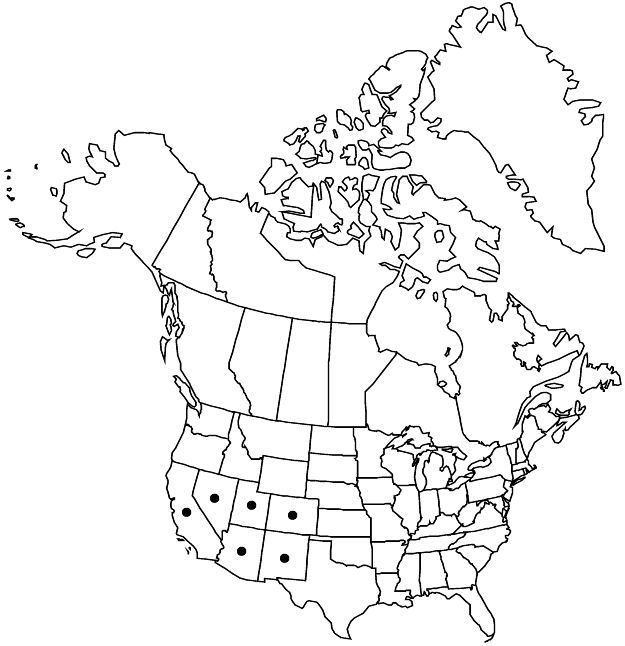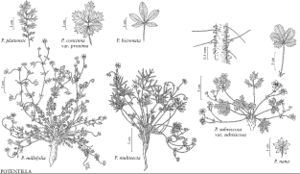Difference between revisions of "Potentilla concinna var. proxima"
Great Basin Naturalist 42: 25. 1982.
FNA>Volume Importer |
FNA>Volume Importer |
||
| Line 24: | Line 24: | ||
|name=P. beanii | |name=P. beanii | ||
|authority=Clokey | |authority=Clokey | ||
| − | }}{{Treatment/ID/Synonym | + | }} {{Treatment/ID/Synonym |
|name=P. diversifolia var. proxima | |name=P. diversifolia var. proxima | ||
|authority=(Rydberg) Soják | |authority=(Rydberg) Soják | ||
| Line 43: | Line 43: | ||
|distribution=Ariz.;Calif.;Colo.;Nev.;N.Mex.;Utah. | |distribution=Ariz.;Calif.;Colo.;Nev.;N.Mex.;Utah. | ||
|discussion=<p>Of conservation concern.</p><!-- | |discussion=<p>Of conservation concern.</p><!-- | ||
| − | --><p>Variety proxima is the primary phase of Potentilla concinna in the mountains of southwestern Colorado, Nevada, and Utah. Some alpine collections from New Mexico are referable to var. proxima, and isolated populations also occur in the San Francisco Peaks of Arizona (at higher elevations than otherwise sympatric var. concinna) and the White Mountains of California. Specimens from Montana keying here are provisionally placed in P. macounii.</p><!-- | + | --><p>Variety proxima is the primary phase of <i>Potentilla concinna</i> in the mountains of southwestern Colorado, <i>Nevada</i>, and Utah. Some alpine collections from New Mexico are referable to <i></i>var.<i> proxima</i>, and isolated populations also occur in the San Francisco Peaks of Arizona (at higher elevations than otherwise sympatric <i></i>var.<i> concinna</i>) and the White Mountains of California. Specimens from Montana keying here are provisionally placed in <i>P. macounii</i>.</p><!-- |
| − | --><p>The most distinctive feature of var. proxima is the elongate flowering stems, which are usually over twice as long as the leaves. Leaves tend to be more sparsely cottony and less bicolored than in the typical variety, the central leaflet is more often petiolulate, and flowers are commonly somewhat smaller. Collections from southwestern Utah and adjacent Nevada, including the type of Potentilla proxima, commonly have subpalmate leaves; elsewhere leaves are rarely or scarcely subpalmate.</p> | + | --><p>The most distinctive feature of <i></i>var.<i> proxima</i> is the elongate flowering stems, which are usually over twice as long as the leaves. Leaves tend to be more sparsely cottony and less bicolored than in the typical variety, the central leaflet is more often petiolulate, and flowers are commonly somewhat smaller. Collections from southwestern Utah and adjacent <i>Nevada</i>, including the type of <i>Potentilla</i> proxima, commonly have subpalmate leaves; elsewhere leaves are rarely or scarcely subpalmate.</p> |
|tables= | |tables= | ||
|references= | |references= | ||
| Line 68: | Line 68: | ||
|publication year=1982 | |publication year=1982 | ||
|special status=Conservation concern;Endemic;Selected by author to be illustrated | |special status=Conservation concern;Endemic;Selected by author to be illustrated | ||
| − | |source xml=https://jpend@bitbucket.org/aafc-mbb/fna-data-curation.git/src/ | + | |source xml=https://jpend@bitbucket.org/aafc-mbb/fna-data-curation.git/src/8f726806613d60c220dc4493de13607dd3150896/coarse_grained_fna_xml/V9/V9_261.xml |
|subfamily=Rosaceae subfam. Rosoideae | |subfamily=Rosaceae subfam. Rosoideae | ||
|tribe=Rosaceae tribe Potentilleae | |tribe=Rosaceae tribe Potentilleae | ||
Revision as of 18:15, 18 September 2019
Stems (0.2–)0.6–1.6 dm, lengths 2–3(–4) times basal leaves. Basal leaves usually palmate to subpalmate, sometimes subpinnate; leaflets on tip or to distal 1/4 of leaf axis, ± overlapping, proximal pairs sometimes doubled often separated from others by 1–5(–10) mm of leaf axis; distal 1/3–2/3 of central leaflets incised 1/4–1/2 to midvein, teeth 2–4 per side, 1–3(–5) mm. Inflorescences (1–)3–12-flowered. Petals (2.5–)4–6 mm. Achenes 1.5–2 mm.
Phenology: Flowering mid summer.
Habitat: Alpine tundra, windswept ridges, stony meadows
Elevation: 2600–3900 m
Distribution

Ariz., Calif., Colo., Nev., N.Mex., Utah.
Discussion
Of conservation concern.
Variety proxima is the primary phase of Potentilla concinna in the mountains of southwestern Colorado, Nevada, and Utah. Some alpine collections from New Mexico are referable to var. proxima, and isolated populations also occur in the San Francisco Peaks of Arizona (at higher elevations than otherwise sympatric var. concinna) and the White Mountains of California. Specimens from Montana keying here are provisionally placed in P. macounii.
The most distinctive feature of var. proxima is the elongate flowering stems, which are usually over twice as long as the leaves. Leaves tend to be more sparsely cottony and less bicolored than in the typical variety, the central leaflet is more often petiolulate, and flowers are commonly somewhat smaller. Collections from southwestern Utah and adjacent Nevada, including the type of Potentilla proxima, commonly have subpalmate leaves; elsewhere leaves are rarely or scarcely subpalmate.
Selected References
None.
